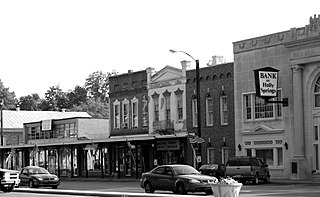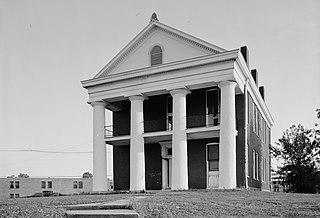
Holly Springs is a city in, and the county seat of, Marshall County, Mississippi, United States, near the border with Tennessee to the north. As of the 2020 census, the population was 6,968, down from 7,699 in 2010. Along with the Mississippi Delta, in the 19th century, the area was developed by European Americans for cotton plantations. After the Civil War, many freedmen continued to work in agriculture as sharecroppers and tenant farmers.

The National Register of Historic Places in the United States is a register including buildings, sites, structures, districts, and objects. The Register automatically includes all National Historic Landmarks as well as all historic areas administered by the U.S. National Park Service. Since its introduction in 1966, more than 90,000 separate listings have been added to the register.

The Mississippi Blues Trail was created by the Mississippi Blues Commission in 2006 to place interpretive markers at the most notable historical sites related to the birth, growth, and influence of the blues throughout the state of Mississippi. Within the state the trail extends from the Gulf Coast north along several highways to Natchez, Vicksburg, Jackson, Leland, Greenwood, Clarksdale, Tunica, Grenada, Oxford, Columbus, and Meridian. The largest concentration of markers is in the Mississippi Delta, but other regions of the state are also commemorated. Several out-of-state markers have also been erected where blues with Mississippi roots has had significance, such as Chicago.

The Alabama Historical Commission is the historic preservation agency for the U.S. state of Alabama. The agency was created by an act of the state legislature in 1966 with a mission of safeguarding Alabama's historic buildings and sites. It consists of twenty members appointed by the state governor or who serve in an official position. The members represent a broad cross section of Alabamians including architects, historians, archaeologists, and representatives of state universities. The commission is tasked with acquisition and preservation of historic properties and education of the public about historic sites in Alabama.

Chamberlain-Hunt Academy was a boarding school in Port Gibson, Mississippi. The school was founded in 1830 as Oakland College and closed in 2014.
A Mississippi Landmark is a building officially nominated by the Mississippi Department of Archives and History and approved by each county's chancery clerk. The Mississippi Landmark designation is the highest form of recognition bestowed on properties by the state of Mississippi, and designated properties are protected from changes that may alter the property's historic character. Currently there are 890 designated landmarks in the state. Mississippi Landmarks are spread out between eighty-one of Mississippi's eighty-two counties; only Issaquena County has no such landmarks.
The Civil War Trust's Civil War Discovery Trail is a heritage tourism program that links more than 600 U.S. Civil War sites in more than 30 states. The program is one of the White House Millennium Council's sixteen flagship National Millennium Trails. Sites on the trail include battlefields, museums, historic sites, forts and cemeteries.

Oakland College was a private college near Rodney, Mississippi. Founded by Jeremiah Chamberlain in 1830, the school was affiliated with the Presbyterian Church. It closed during Reconstruction, and some of its former campus is now part of the Alcorn State University Historic District.
Claude H. Lindsley was an American architect based in Mississippi.







